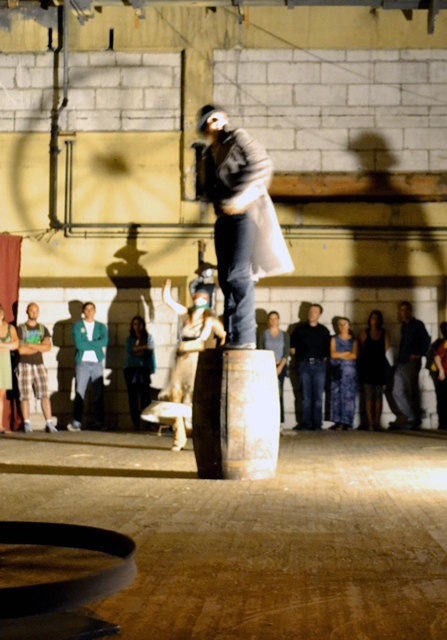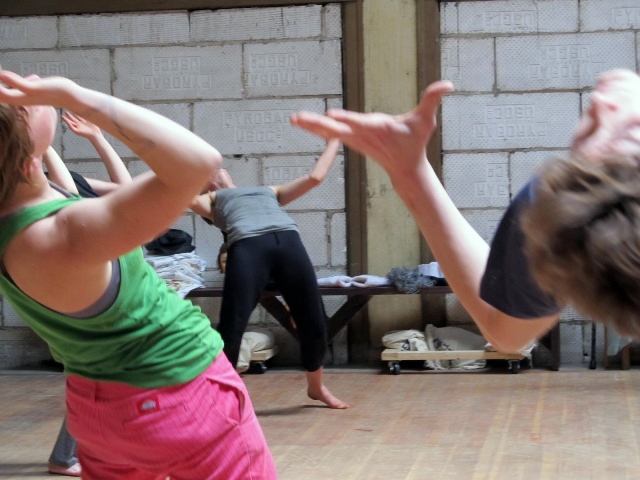An Afternoon of Irrational Movement with the Hinterlands
Matthew Piper
The Hinterlands' chronically inventive, genre-exploding productions like Manifest Destiny! (there was blood on the saddle) (fig. 1) catapult the spectator into a palpitant state of heightened engagement by the sheer force of their unflagging originality, dynamism, and cock-eyed beauty, as well as the unexpected demands they make of their audience. Stand up, for instance. Shout. Move around. Split up. Change seats. Get closer. Sing along ("There was blood o-o-o-n the saddle….").
The physicality of the Hinterlands audience makes good sense when considered alongside the essentially physical way that co-founders & directors Richard Newman and Liza Bielby create and develop their work. As Richard once put it, "We don’t ever sit down and write a script. We create on our feet, engaging in lengthy periods of physical training and improvisation as well as character and image development…." While their primary concern with the active body never had to extend from the performer to the spectator, considering the Hinterlands' interest in smudging lines, it's no wonder that it did. In addition to their performances, the Hinterlands notably offer another way for the "spectator" to engage their work and to "radically reimagine [her] relationship" with them even further, a way, in fact, to transcend the role of spectator entirely -- to become, instead, a kind of co-creator of a unique and evanescent abstract physical event. On and off for three years, Liza and Richard have hosted "open trainings," intensely physical participatory workshops that are a key component of their practice, and that are open to adventurous performers and non-performers alike. On a frigid Sunday afternoon several weeks ago, unsure exactly what to expect, I attended my first such workshop. Little could have prepared me for the three singular hours that followed, during which I found myself leaping vigorously outside the habitual confines of daily life and into the ecstatic, demanding, and slightly lunatic world the Hinterlands call home -- a place where physical, mental, and social boundaries are soundly obliterated by the force of concerted bodily exertion. We began, routinely enough, by stretching. (Actually, we began by paying $15 and signing a release form.) "We" were a dozen or so people, a group that included both workshop veterans and intensely curious first timers. We were inside the open, 625 square foot main room of Play House, the 1924 two-family home in Banglatown that was recently converted into the Hinterlands' professional HQ by Powerhouse Productions. Liza and Richard welcomed us and explained that our time together would consist of two parts: a longer, almost exclusively physical first act followed by a shorter, less physical, second. With that, Richard put on some music and we began. We moved -- variously, continuously, and, for the most part, wordlessly -- for two hours (fig. 2).
During much of that time, we played follow the leader, watching and emulating the movements of our hosts as they reached, strained, leaned backward, leapt forward, flopped to the side, sprinted, collapsed, crouched, dived, whirled, and exploded into the air. Their mutable movement vocabulary was a cross-cultural melange of styles and traditions; the most pedestrian gesture was followed by the most balletic, the balletic by the vaudevillian. Such a resolutely physical experience is difficult to recall in detail and describe, but certain moments left their mark: We made a circle, like Busby Berkeley dancers, that expanded, contracted, and turned like a wheel. The wheel still turning, we began to move in quick, short, crouching steps, forearms stacked parallel in front of torsos, thumbs pressed against middle and ring fingers: a form, Liza later explained, from traditional Sichuanese folk opera. Then, heavier, we moved in a sort of prolonged, slow-motion stumble, no longer in unison or mimicking the same gestures, but guided instead by the weight of our own individual bodies as they alternately succumbed to and resisted gravity's insistent tug. "Don't decide where to go," Richard said, encouraging us to let go of intention and see where we ended up. The pace quickening again, layers were shed, sweat stains spread, and the pungent stink of our collective effort began to permeate the space. We moved past one another now in propulsive, decisive leaps. Liza, turning our perception inside out, said: "Be aware of each other. When you land near someone, spend a moment together." Wordless communication drew us nearer still, until, pressed against one another in a dense and shifting mass of trunks and limbs, we used our bodies architecturally: strangers climbed upon one another -- bare feet and hands on each others' thighs and shoulders for support, others' arms extended to catch them if they fell -- and safely descended. Gradually, fluidly, without verbal direction, we became two groups, one led by Liza and the other by Richard. We were transitioning out of our world of abstract movement into something that Richard later referred to as an "imaginative, image-based world." Made available to us were the sparest notions of costume (an assortment of hats), prop (a long piece of blue fabric, good for a blanket or a river), and set (a costume rack on wheels; a chest). Suddenly, there was drama afoot: our camps now in opposition, we chased each other, glowered at each other; now in deference, we bowed low and extended our hats. The members of my group, led by Liza, lay down and briefly feigned sleep, taking refuge under the blanket, while the others conspired behind the costume rack. We made our blanket a surging river, and Richard emerged from behind the rack, eyes wild, voice booming, bearing a portentous, inscrutable message about a bitter root…. A brief break to drink, blink, stretch, and be still followed our period of make-believe, and after it came the second part of the training, during which we each spent about fifteen minutes with an object (a pipe, for instance, a tube, an umbrella, a scale) and explored its unique properties: its weight, the way it balanced; ways that it moved or caught the light, ways we might use it. After our silent explorations, we each explained and demonstrated three things we found interesting about our object, or interesting ways we'd discovered it could be used. There were half as many objects as people, so each object was explored twice. Is it surprising that it was so easy, so natural, to divine and discuss six distinct properties of a pipe, a tube, an umbrella, a scale? * * * We move, most of us, in such prescribed, expected, rational ways. We move to get things done, to accomplish tasks or achieve goals. Walk, jog, climb the stairs. Sit, stand, catch the ball. Even ecstatic movements, like those we might find in yoga, in sex, in dancing, can become familiar, rote, over time. Our bodies become sites of sameness. The bodies of innovative performers at work, by contrast, are more likely to become sites of variety, resistance, inquiry, and exploration. The Hinterlands train the way they do, Richard told me, in part to "push [them]selves, to end up in irrational places." What a rare gift they offer when they invite the rest of us to cross the spectator/performer border and participate in that enlivening process. No two open training sessions are exactly alike. Their unique trajectories result from many factors, including whatever the Hinterlands are working on at a given time, as well as the "balances, states of energy, the pushes and pulls" that naturally occur among the individual participants. (Our object explorations, for example, were not previously scheduled. Liza later told me that she and Richard decided to go down that road in order to restore the flagging energy of our exhausted group.) I cannot begin to imagine what these workshops might mean to a performer. For the non-performer, they provide the extraordinary opportunity to become part of an ensemble that works together to create something difficult, beautiful, and fleeting; to imbue the body with intentionality and awareness; to free the mind and the body from the familiar bonds of rationality and habit; to play; to touch and trust strangers; to catch a dizzying glimpse of what lies beyond. |
||||||
The next Hinterlands open training takes place on Sunday, March 16th from 2-5 pm at Play House, 12657 Moran St. It costs $15. RSVP to info[at]thehinterlandsensemble[dot]org or call (313) 454-1756. |
This text is by Matthew Piper in his capacity and does not, necessarily, reflect the views of different infinite mile contributors, infinite mile co-founders, the authors' employers and/or other affiliations.


